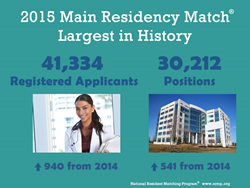NRMP 2015 Residency Match Largest on Record with More Than 41,000 Applicants Vying for Over 30,000 Residency Positions in 4,756 Programs


Washington, D.C. (PRWEB) March 20, 2015
The National Resident Matching Program® (NRMP®) announced today the results of what has turned out to be the largest Main Residency Match® in NRMP history. Nearly 17,000 U.S. allopathic seniors and more than 9,000 other applicants matched to one of the more than 27,000 first-year positions offered in the 2015 Match. The seniors learn their fates today at medical school Match Day ceremonies held across the country. Match Day is an annual rite of passage for medical students, a day when they learn at which U.S. residency programs they will train for the next three to seven years.
The 2015 Match included 41,334 total registrants, the largest number on record. The growth in the number of U.S. seniors, 651 more than last year, is due to rising medical school enrollments and the many new schools being established. More than 30,000 total positions were offered in 2015, an all-time high. Half of the 600-plus new first-year positions were in the primary care specialties of Family Medicine, Internal Medicine, and Pediatrics.
“We are immensely proud of the success of the Match and welcome the growth in applicant and program participation,” said NRMP President and CEO Mona M. Signer. “We are especially pleased to see increases in the primary care specialties. Nearly 60 percent of the growth in first-year positions is attributable to primary care, a very positive trend.”
Participation and Match Rates for Applicant Groups
Of the 18,025 U.S. allopathic seniors who submitted program preferences for the 2015 Match, 16,932 matched to first-year positions, achieving an overall match rate of 93.9 percent. The number of matched seniors, 500 more than last year, is an all-time high. Of the U.S. seniors who matched, 51.6 percent matched to their first choice for training.
In addition to U.S. allopathic seniors, 2,949 osteopathic medical school students and graduates submitted program preferences for this year’s Match, an increase of more than 200. Their match rate to first-year positions rose to 79.3 percent, the highest ever. There were 119 fewer U.S. citizen international medical school students/graduates (IMGs) submitting program preferences in the Match and 32 more non-U.S. citizen IMGs. Match rates for both groups were virtually unchanged. The biggest decline was noted among previous graduates of U.S. allopathic schools. Those submitting program preferences decreased from 1,662 to 1,520 this year, and the match rate fell by 4.4 percentage points.
Position Fill Rates and Trends
Results of the Match are closely watched because they are predictive of future changes in physician manpower supply. The total number of positions offered reached an all-time high, and increases were noted in the number of primary care programs and positions offered in the Match:
Internal Medicine programs offered 6,770 positions, 246 more than in 2014; 98.9 percent of positions filled, and 49.0 percent filled with U.S. seniors
Family Medicine programs offered 3,195 positions, 86 more than in 2014; 95.1 percent of positions filled, and 44.0 percent filled with U.S. seniors
Pediatrics programs offered 2,668 positions, 28 more than in 2014; 99.5 percent of positions filled, and 70.8 percent filled with U.S. seniors
Specialties in the 2015 Match that offered at least 20 first-year positions and filled all of them were Dermatology, Medicine-Psychiatry, Obstetrics and Gynecology, Orthopedic Surgery, Pediatrics-Primary Care, Physical Medicine/Rehabilitation, and Thoracic Surgery. General Surgery, Neurological Surgery, Otolaryngology, Plastic Surgery, and Radiation Oncology were specialties that had fewer than 5 unfilled positions after the matching algorithm was processed.
Couples in the Match
The NRMP allows any two applicants to participate in the Match as a couple by linking their preference lists so they can match to a suitable pair of programs. An all-time high of 1,035 couples participated in the Match, 110 more than last year, with a 94.8 percent match rate.
Unmatched Applicants
Applicants who did not match to a residency position participated in the NRMP Match Week Supplemental Offer and Acceptance Program® (SOAP®). During SOAP, the NRMP makes available the locations of unfilled positions so that unmatched applicants can apply for them using the AAMC Electronic Residency Application Service® (ERAS®). This year, 1,193 of the 1,306 unfilled positions were offered during SOAP.
Match Data Reports Online
View the 2015 Advance Data Tables and complete Match data reports from previous Matches on the NRMP Match Data page. View and download 2015 Main Residency Match infographic
The NRMP Match
The Match uses a computerized mathematical algorithm to align the preferences of applicants with the preferences of residency program directors in order to fill training positions available at U.S. teaching hospitals. Research on the NRMP algorithm was a basis for awarding The Sveriges Riksbank Prize in Economic Sciences in Memory of Alfred Nobel in 2012.
About NRMP
The National Resident Matching Program® (NRMP®) is a private, non-profit organization established in 1952 at the request of medical students to provide an orderly and fair mechanism for matching the preferences of applicants for U.S. residency positions with the preferences of residency program directors. In addition to the annual Main Residency Match® for more than 40,000 applicants, the NRMP conducts Fellowship Matches for more than 50 subspecialties through its Specialties Matching Service® (SMS®).
###